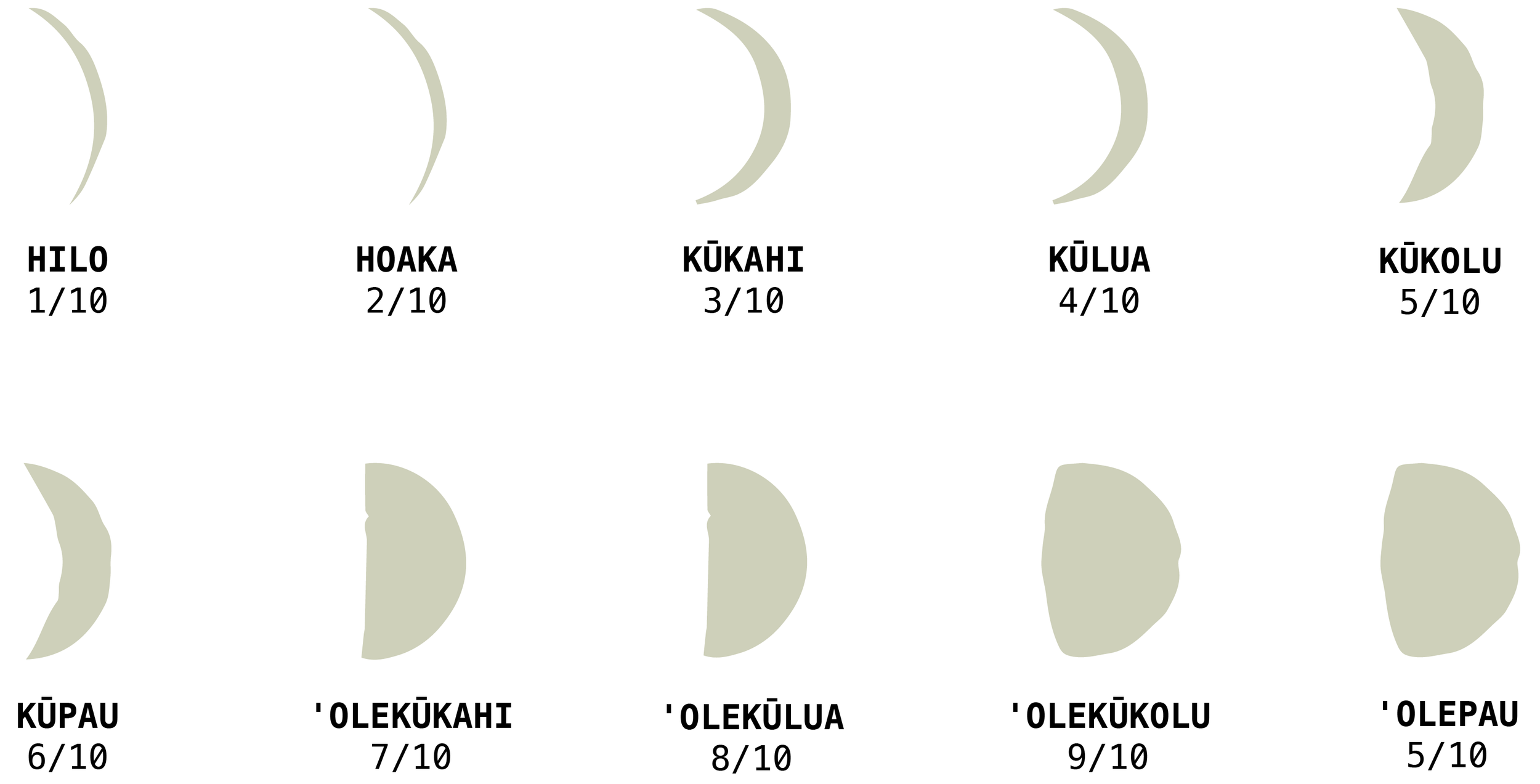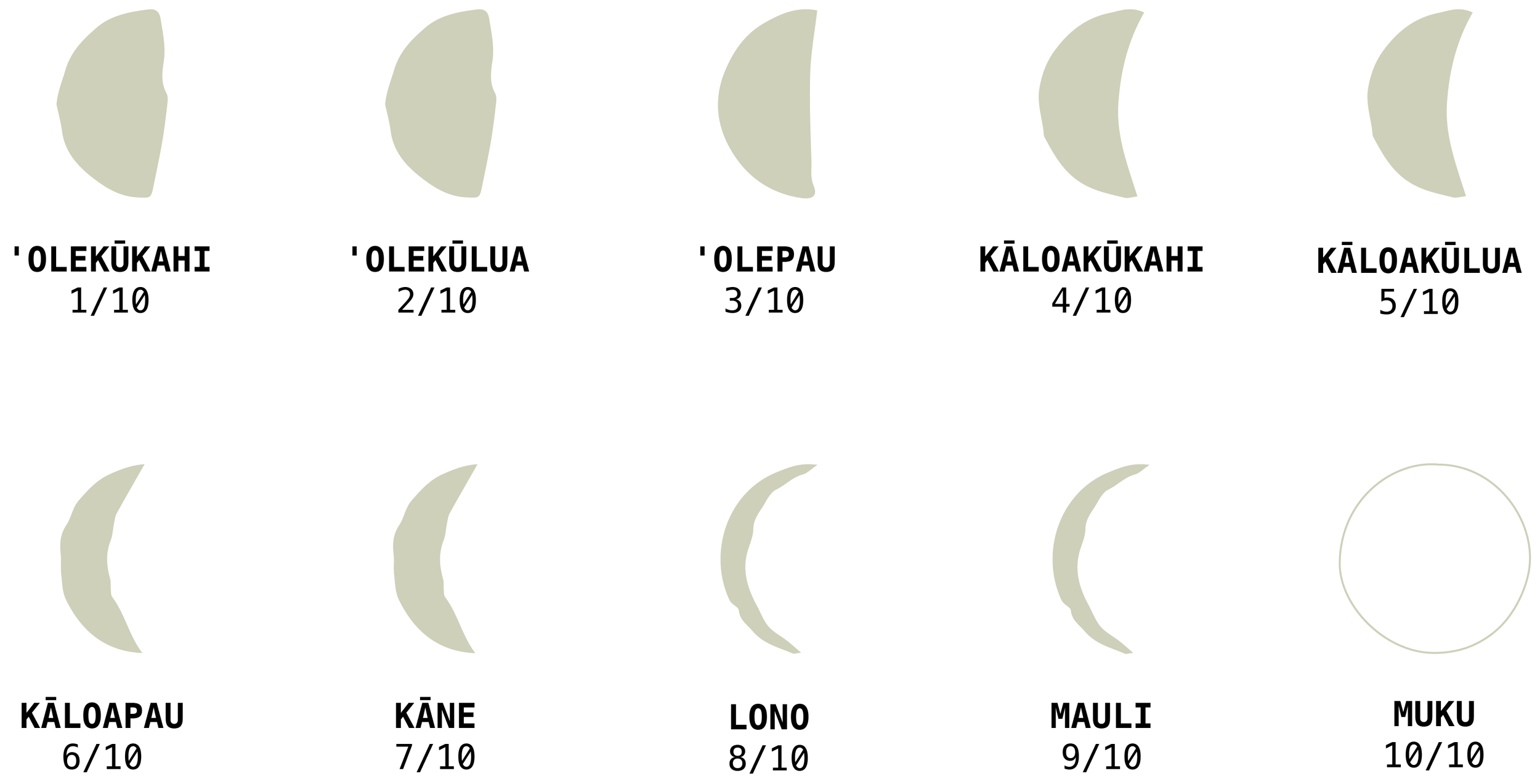Helu Pō
There are 30 Hawaiian-named moon phases each bearing significant meaning to Hawaiian culture and practice. Much like the moon affects the tides, the fishing and farming habits of ancient Hawaiians were also influenced by the lunar cycle.
These 30 nights are split into three anahulu, a period of ten nights. These three anahulu include Ho'onui (Waxing Phase), Poepoe (Full Moon Phase), and Hō'emi (Waning Phase).
A Note from Mālie
Please note that while these explanations are a collective of oral accounts, personal observations, online research, and what we could read in books, this merely serves as a jumping off point that'll hopefully pique your interest should you wish to dive deeper into the practice of kilo: close observation of the world around you. Much like how the moon rise and setting times vary for each island-the behavior of our ocean, its species, and planting habits also vary.
A good example of this comes from an oral account by my dad, a waterman who spent his whole life fishing and observing the ocean and behaviors of the fish in season. He noticed that certain fish will bite on a "small" moon at certain shorelines but will also bite on a "big" moon at other shorelines.
Such a seemingly small detail realized by years of observing habits of the world you live in can really make a difference in providing for you and your community. More importantly, being aware of the world we live in will also teach us how to better care for it.
Anahulu Ho’onui
Waxing Phase
HILO — After MUKU, of the new moon, HILO is the first visible sliver of light. Hilo, meaning “to twist”, is sometimes interpreted literally. It is believed that crops will grow twisted if planted under this moon phase. Thus, HILO is considered a bad time for farming.
HOAKA — HOAKA, meaning “crescent”, is the first moon phase bright enough to cast a shadow, scaring fish away. For the moon phases HILO and HOAKA, tides rise in the early mornings and late afternoon—low tides occur during the late mornings.
NĀ MAHINA KŪ — The four nights of KŪ signify a good time to plant crops as they will grow to be KŪ, meaning tall and erect. Though currents tend to be strong, fishing is also favorable during the moon phases of KŪ.
NĀ MAHINA 'OLE — 'OLE, meaning “nothing”, was thought to be a moon phase of very little productivity. Ocean tides are high and tend to be rough during this period. Although 'oOLE moons are considered unproductive, they are useful for preparation, organization, and the mending of materials.
Anahulu Poepoe
Full Moon Phase
HUNA, MŌHALU, & HUA — HUNA marks the first night of the second anahulu, followed by MŌHALU and HUA. These three nights, meaning “hidden”, “unfolding”, and “egg”, respectively, speak to the nature of these moons. HUNA and MŌHALU are considered good times for planting — HUNA for hidden-root vegetables and MŌHALU for flowers that blossom. The Hua moon resembles an egg and is a nod to the moon becoming rounder.
AKUA, HOKU, MĀHEALANI, & KULU — AKUA, HOKU, and MĀHEALANI are the three fullest moons of the thirty phases and cause the tides to rise and fall dramatically. These moons rise late, are high in the sky, and are still visible the morning after. The full moons are praised for both fishing and planting and considered beneficial for all kinds of work. KULU, meaning “to drip”, marks the end of the full moons.
NĀ MAHINA LĀ'AU — The literal translation of lā'au is “tree” or “plant”. Hence, it is believed to be another period that is good for farming. As the moon phases start to switch, the oceans become rough and the late rising moon is still visible in the early mornings. These three moons signify the ending of the second anahulu and the last of the rounded moons.
Anahulu Hō'emi
Waning Phase
NĀ MAHINA 'OLE — The second set of 'OLE moons signify another unproductive time period. The oceans are rough—currents run strong and bring jellyfish and Portuguese man o war. Contrary to its name, these nights of 'OLE are a useful time to perform repairs and make any necessary preparations for the coming moon phases.
NĀ MAHINA KĀLOA — The strong currents from the ‘OLE moons carry into the moon phases of KĀLOA. Although jellyfish and man o war continue to be pushed into shallow waters, the fishing is favorable during this time. The high tides occur in the early afternoons and late into the night.
KĀNE, LONO, & MAULI — Favorable fishing practices and conditions last until the end of Ho'ēmi. As their names suggests, the phases of KĀNE and LONO are a designated time of worship to their namesakes. MAULI is the last night where the moon is visible. Prominent low tides on these last few nights of the lunar cycle encourage reef fishing.
MUKU — Since no shadow can be cast on a night with no moon, it is an excellent night for all kinds of fishing. Muku, the last moon of thirty, rises completely hidden. PAU.
SOURCES
The lunar phases are provided by the Ka Mahina Project and are listed in accordance to their respective meridian passing time to the island of O'ahu.
'Ano Lani: 'Ano Honua, A Heavenly Nature; An Earthly Nature
By Kahu Wendell Kalanikapuaenui Silva
Hawaiian Lunar Month, Hawaiian Voyaging Traditions, Polynesian Voyaging Society.
Kaulana Mahina: The Position of the Moon. Ka’iwakīloumoku Pacific Indigenous Institute, Kamehameha Schools.



